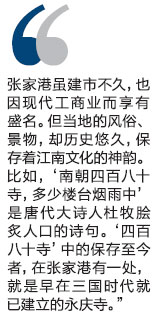Temple known for three wonders, an author and examinees

It seems appropriate that a city as affluent as Zhangjiagang would host an ancient temple devoted to wealth.
Yongqing is a 1,500-year-old holy site where pilgrims have prayed for prosperity since the Three Kingdoms period (AD 220-280).
Hence its Hall of Mammon.
Their prayers have been answered.
Today, the city's GDP is equivalent to that of a northwestern province.
But Yongqing is priceless in itself.
It's one of the oldest remaining southern Chinese temples of its kind. And recent expansions have added value - especially the Buddhist Culture Garden.
Part of its claim to fame comes from its "three wonders": a natural stone wall, a 1,000-year-old tree and a massive bodhisattva statue.
These hail from, and represent, layers of time.
The rock formation is millions of years old. The tree is from a millennium ago. And the towering Guanyin figure was installed when the garden was created in 2008.

Small golden Buddhist figures are perched along the gingko trunk from the temple's first days. (It, plus two pillar foundations, are all that linger from that period.)
The tree died long ago, but it has been preserved as a testimony to the temple's early life. It's propped against a walkway flanked by likenesses of the 12 creatures of the Chinese zodiac. Petting the one of your birth year as you walk past is said to bring good luck.
But the most striking sculptures occupy the culture garden.
Orthodox members of Buddhism's pantheon cohabit with unexpected cameos. Five bodhisattvas sit in the center of a courtyard in which the walls are flanked with 108 reliefs of arhats. Between them frolic 20 cutesy kids - their renderings ranging from cartoony to goofy - who practice kung fu and golf wearing split pants.
Their style is distinct from the cherubic tot who totters atop a three-tiered fountain that would seem more at home in a Victorian aristocrat's garden than a Chinese Buddhist temple.
Yet it's a welcome addition to the miscellanea.
At the base of the stairs leading to the hilltop Guanyin, six dragon pillars protrude between the Nine Phoenixes Facing the Sun screen and a large relief emblazoned with the five rings to celebrate Beijing's Olympics.
Further up the hill, adjacent to the garden, stands a pavilion in which giant golden Buddhist figures gaze under glaring lights. On the wall behind them, 500 small clay abbots cling to polychromatic juts of rock in the shadows.
It's hard to tell if the striking contrast is intended as a commentary on the divine versus the earthly. But either way, it is.
Slogging upward leads to Wenchang Hall, the highest point of the temple and the surrounding area.
This has become a destination for pilgrims - especially students - praying for high academic scores.
That's partly because it served as a study hall for a successful imperial-exam taker and the abode of author Shi Nai'an. Shi lived there when he penned The Water Margin - one of the four "Chinese classics".
He made a living fortunetelling on the ground floor during the daytime and wrote his masterpiece in the loft at night.
The novel's "Devils-subduing Hall" is based on the Hall of Life and Death behind Wenchang.
This history has made it a place for pupils to plea to the Wenchu star idols and Wenchang emperor to bless them with the knowledge needed to earn high marks, especially on the national college entrance examinations.
Zhangjiagang's current prosperity and advanced education is perhaps the natural cultivation of modern conditions.
But Yongqing shows hopes were long ago sown with supernatural seeds.
Whether one explains the city's rise via rationalism or religion - or a bit of both - the temple testifies to a historical root for an ethos that has sired much fruit.
(China Daily European Weekly 10/22/2015 page8)
Today's Top News
- Japan tempting fate if it interferes in the situation of Taiwan Strait
- Stable trade ties benefit China, US
- Experts advocate increasing scope of BRI to include soft power sectors
- New engine powers cargo drone expansion
- China to boost green industry cooperation
- Manufacturing PMI rises in November






























